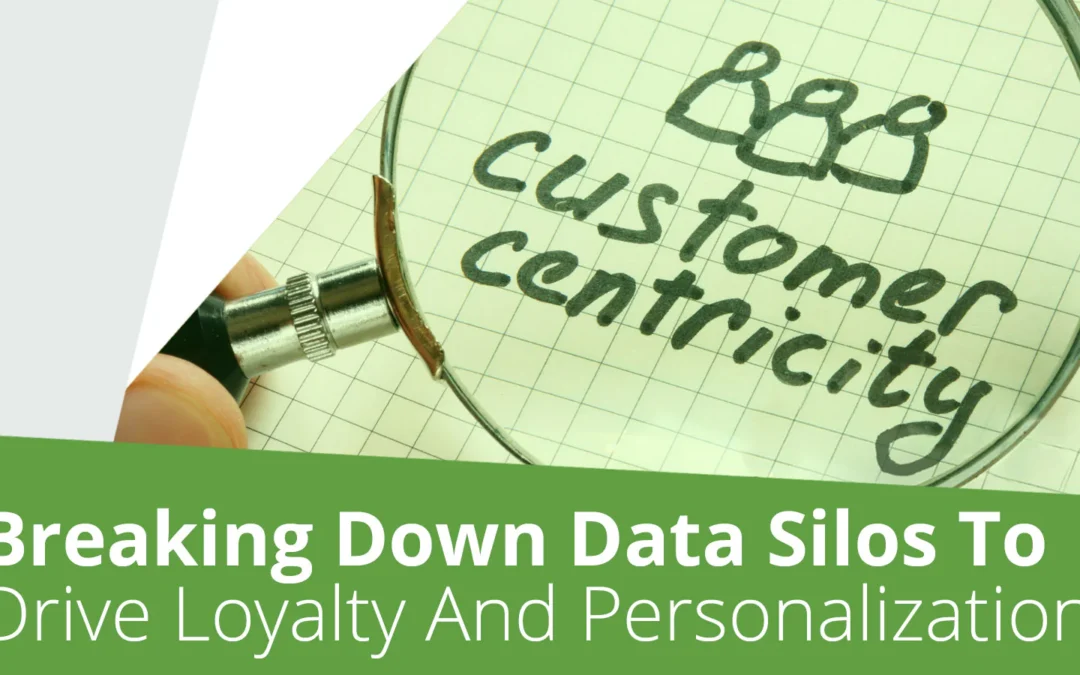Personalization in Marketing Is No Longer Optional
Data Silos Are Silent Killers
According to SmarterHQ, 63% of consumers stop purchasing products and services from companies who poorly execute personalization. Personalization is good for business. In fact, Adweek reports that personalization can reduce acquisition costs by as much as 50%, increase revenues up to 15% and increase marketing spend efficiency as much as 30%. No wonder that, according to Forrester, 89% of digital businesses—including Coca-Cola, Netflix, Sephora and Wells Fargo—are investing in personalization. So, what’s the catch? Effective personalization requires organizations to be truly customer-centric and have the ability to seamlessly share customer data across their tech stack.
In addition, 52% of companies cite data silos as the biggest challenge to being customer-centric (MarketingProfs). Silos segment channels, departments, functions and customer information. A recent Forbes article backed this statistic up, stating “Internal organizational silos can lead to inconsistent and undefined processes, disparate or missing data sources and systems, and misalignment across the supply chain. These challenges can drive up costs and negatively impact accuracy and quality, ultimately impacting the health of the company’s bottom line.” Breaking down silos can help brands better understand their customers’ journey and troubleshoot any gaps or areas that need improvement.
Tadpull’s software Pond is the only solution on the market that can seamlessly integrate data from the three major silos in eComm: customer data, inventory insights, and marketing metrics. Pond is one hub that you can run everything eCommerce with, not only backed by data but also by powerful AI that automatically recommends ways to personalize your converting offers, and the results are so successful they’re hard to believe.
Silos often result in customers having to re-enter their basic information, which is extremely frustrating, undermines trust and gives them good reason to shop elsewhere. Given that, everything has gone digital, being able to deliver a seamless, consistent customer experience is more important than ever. The pressure is on for businesses to tear down silos in order to better engage and delight customers, with the goal of building lasting relationships that ensure retention and loyalty.
Loyalty has evolved way beyond points for purchases, it’s now a business-critical strategy. Why? KMPG International reports that mature brands derive more than 85% of their growth from their most loyal customers, and 86% of loyal consumers surveyed say they’d recommend a brand to family and friends.
Here are just a few of the ways breaking down data silos leads to increased loyalty and, ultimately, business growth:
- When everyone in the business has a shared vision of the customer, experiences across the organization can be more relevant and personal—creating lasting, emotional bonds.
- You can identify your most profitable customers and create unique, exclusive experiences that make them feel special, incent them to spend more and inspire them to share their great experience with others.
- Product development and innovations can be focused around customer feedback, and when these customers see their feedback in action, they will be more likely to upgrade and refer others.
- Every customer-facing contact can be empowered with accurate, relevant customer details in real time, so they can better serve customers and deliver a unified and consistent experience.
According to Deloitte, client-centric companies are 60% more profitable, and being able to dynamically leverage your customers’ data across every touchpoint is a great start.
Customer-Centric Brands Deliver More Value
2021 is the time to put customer needs at the forefront. In the age of empowered customers, companies need to go the extra mile to find out what the customer really wants in order to earn their loyalty and establish a lasting relationship.
Customers expect brands to offer relevant perks to them and respond to their unique needs through personalization and effective loyalty programs. This is why businesses are doubling-down on customer-centric marketing strategies. According to Harvard Professor Ted Levitt, “People don’t want to buy a quarter-inch drill; they want a quarter-inch hole.” Customers want to know what your products can do for them beyond simply features and functionality. It’s all about empathy, listening intently and implementing based on customer feedback. A customer-centric business constantly evolves, understanding their customers and making each customer feel valued. According to American Express, one happy customer brings eight referrals, which results in more leads and more sales.
Data from a variety of studies shows that customer-centricity improves financial performance and provides a competitive advantage:
- Seven out of 10 U.S. consumers say they’ve spent more money to do business with a company that delivers great service.
- Increasing customer retention rates by 5% increases profits by more than 75%.
- It’s almost 25 times more expensive to acquire a new customer than it is to keep an existing one.
- Customers who rate a company as delivering a good customer experience are 34% more likely to purchase more and 37% more likely to recommend the company.
In order to be a successful customer-centric company, it’s important to completely understand what influences your customers, their values, desires, behaviors and expectations. Which means you must integrate individual data, brand awareness data and aggregate data. A loyalty platform and program is an efficient way for a brand to collect and leverage this data. If you understand your customer’s motivations fully, you’ll be able to use the data to create unique experiences for your customers. For brands like Starbucks and Zappos, this has been crucial to building lasting loyalty.
Here are some benefits of being a customer-centric brand:
- A good customer experience can lead to positive online reviews which will further drive incremental revenue growth.
- A customer-centric journey enables you to understand their preferences and interests, enabling you to create loyalty strategies for long-term retention.
- Personalized experiences lead to more satisfaction and sustained loyalty. Fully connected customers are 50% more valuable than a highly satisfied customer.
- Consumer orientation helps you segment your customer base. It allows you to attract and nurture your best clients, and increase their lifetime value as you adapt your strategies based on their needs. According to the Center for Retail Management at Northwestern University, 15% of a company’s loyal customers are responsible for 60% of their total sales.
- Being customer-centric will give you a unique competitive advantage and allow you to identify opportunities for growth.
- A customer-centric brand that incentivizes their customers and incorporates loyalty rewards can create emotional, lasting bonds. Instead of just rewarding customers with monetary perks like free shipping, coupons or free gifts with a purchase—companies are finding success by curating experiential rewards with unique value-adds such as trips, event tickets, exclusive access and more.
Annex Cloud knows successful programs aren’t one-size-fits all. Different reward structures and incentives can accomplish different goals. Our advanced customer retention and loyalty solutions are designed to engage and reward your most valuable and profitable customers.
Tadpull can help you break down the barriers in your data, giving you a holistic, full picture of your eCommerce business from marketing to finance to operations. Once you have the power of complete visibility at your fingertips, loyalty is easier than ever to cultivate. Plus, Annex Cloud’s Loyalty Experience Program is purpose-built to feed first-party data across your tech stack or directly into Pond, so you can start building lasting customer bonds, starting today. Contact us today to learn more.


